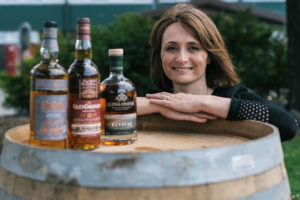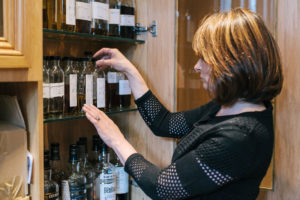By Richard Thomas
BenRiach has become one of the great success stories of modern Scotch whisky. Built in the late 1890s, BenRiach has a history like that of many distilleries in Scotland, having changed hands multiple times and consequently serving the interests of many masters, ultimately leading to obscurity. By the beginning of the 21st Century, BenRiach was barely operating at all. Then in 2004, Scotch industry veteran Billy Walker joined a pair of South African investors to buy BenRiach, revive operations and build a brand. They later added Glendronach and Glenglassaugh to the BenRiach Distillery Company, sometimes simply called “the BenRiach Group.” This culminated in the company’s 2016 acquisition by Brown-Forman, a purchase that saw the owner of Jack Daniel’s and Old Forester re-enter the Scotch industry.
The Brown-Forman buy-out raised the question of who would take the helm at BenRiach, since Billy Walker was rumored to be looking for another project (he bought Glenallachie in 2017). In February 2017, they hired the esteemed Rachel Barrie, at the time Master Blender at Morrison Bowmore.
Although I was offered an early chance to interview Barrie, I thought it would be more interesting to wait several months and come back around after she had spent some time with her new charges. That time has passed and now she has some tales to tell, both about the new job and about the quirks of her career.
RT: You’ve been at BenRiach, Glendronach and Glenglassaugh for several months now. Tell us about how a Master Blender steps into a new inventory like that, takes the reins and starts forming a picture of what she will be able to do with that inventory in the future.
RB: I would describe it more like deep diving than stepping! You need to venture deep into each distillery – every aspect of the stock profile and distillery character has to be learned, considered and understood, from wood ratios to inventory volumes per year, to the subtleties of spirit character with different malt peating levels, distilling seasons and maturing years, when stored in different cask types, locations and warehouses. It’s like getting to know a new friend, understanding their quirks, strengths and sensitivities, knowing when to push the boundaries and seek new adventures, and when to leave in peace. Each distillery is an individual, from the curious, experimental and surprising BenRiach to the masterful, robust and deep GlenDronach, and the coastal elemental nature of Glenglassaugh. The character of each distillery provides the palette to bring to life.
RT: You’ve described your new trio of distilleries as “underdogs,” and also used that term to describe what Ardbeg was like when you started working there in 1997. Ardbeg is now a huge fan favorite brand, of course. What lessons did you glean from Ardbeg that you might apply to your new trio?
RB: I think of each distillery as a maze or a ‘puzzle to solve’, to understand each twist and turn and find the best way through. I’ve been very lucky to work with both small and large distilleries, each with their own puzzles and rollercoasters. Over time I’ve learned that whisky-making is a journey of curiosity and courage, to work out what’s the perfect balance, when to experiment, and with what and how, and a quest to reach the pinnacle on a never-ending journey of continuous improvement. BenRiach, Glendronach and Glenglassaugh are phenomenal single malts just at the start of their global growth, and I am hugely excited to be part of this.
RT: What features of those three distilleries make them stand out from the hundred-odd distilleries of Scotland?
RB: Where do I start with such characterful individuals ?!
Benriach’s three-way distilling style, unpeated, peated and triple-distilled, and eclectic range of cask types, never ceases to pique the curiosity. Forward-thinking, progressive and unconventional, BenRiach takes experimentation to the next level, so we can always look forward to the next surprise. Out latest surprise is BenRiach 21 year old, unconventionally matured in four cask types: Bourbon, PX, Virgin oak and red wine casks.
GlenDronach is renowned for its mastery of sherry cask maturation, rooted in 19th century Highland tradition. It has a deeper and more robust character than the other ‘glens’, counterbalanced by brambly fruit elegance, delivering a particularly long and richly satisfying finish. This can be found in the 12 year old Original, intensified in the 18 year old Allardice and lingers long into the 21 year old Parliament.
Glenglassaugh’s coastal location, at Sandend beach, near the local fishing town of Portsoy on the North coast, straddles the Speyside and Highland regions, making it one of the most highly distinctive malts in Scotland with its lush, elemental coastal sweetness, spiced by land and sea. Striking a balance between full-bodied and fresh, this is a great malt to enjoy outdoors, embracing nature’s elements.
RT: You’ve been sampling whiskies professionally now for a quarter-century, and the number of casks you’ve dipped into must be well over 100,000 by now. Do you recollect a real oddball, the kind of thing you pulled the bung out of it and thought “OK, that is absolutely not what I was expecting.”
RB: Yes, sampling casks is a wonderful part of the job, and yes, there are often surprises! Fairly recently, I would say GlenDronach Peated single malt matured in a Port cask has surprised me. With berries, stewed barley underfoot and sooty bonfires in the fields, I was instinctively taken aback by its unusual melting pot of smells. I vividly recall imagining I was just below the railway station, as the engines stopped and started, puffing out sooty smoke – alongside the smell of strawberry jam, bramble apples fallen from the tree, stewed barley and wet earthy grass, with the coal bunker in the corner and smoke from the open fireside wafting out the door. Not sure what I expected, but this was much more, and took me somewhat by surprise as, in all my years in whisky, I’d never experienced this taste combination in a whisky before, even though it paradoxically reminded me of times long ago.
RT: You work for Brown-Forman now. What whiskies would you recommend to lure a drinker of Jack Daniel’s or Old Forester into Scotch?
RB: Tough question, as I’m not one for luring! They’re all great and it’s a matter of taste and personal choice. However, life is a journey made all the richer for its multi-dimensions, so here goes…
For the adventurous souls who’d like to try single malt Scotch, I’d recommend BenRiach 10 year old. With an eclectic taste like a fruit orchard in the Caledonian pine forest resting on a bed of cotton candy, this is a great place to start your ascent into single malt.
For those ready to move deeper into a malt revered as the ‘sherry cask connoisseur’, I’d recommend GlenDronach 12 year old The Original. With its masterful balance of elegant top note finesse, robust malt structure and richly satisfying long finish, this is a single malt best sipped and savoured with time.
If you are drawn to the invigorating elemental smells of the coast, I’d recommend Glenglassaugh Evolution. With the enlivening smell of lush coastal sweetness spiced by North sea air, this is a single malt that surfs on the palate like the sea.
RT: Your career has taken you back and forth across Scotland. When you think of a good place to get a good pour of whisky or perhaps some good whisky and some good food, what comes to mind?
RB: Back home in Aberdeenshire springs to mind. In particular, Glen House at GlenDronach Distillery, where I can sip and savour GlenDronach in the lounge overlooking the walled garden and distillery, whilst enjoying the scenery of the rolling hills above the glen, and authentic hearty Highland food in the dining room, before falling asleep in darkness under the bright moonlight surrounded by the wonderful smells of the distillery.
For the public and in Scotland, I would recommend hotels such as The Craigellachie Hotel, The Mansion House in Elgin and Meldrum House Hotel in Aberdeenshire. These are all in ‘distilling country’ in the north east of Scotland, and perfect bases to visit the distilleries, enjoy the whiskies and sample local produce in the environment in which they are made.
 The Whiskey Reviewer A World of Whiskey, Poured Every Weekday
The Whiskey Reviewer A World of Whiskey, Poured Every Weekday


